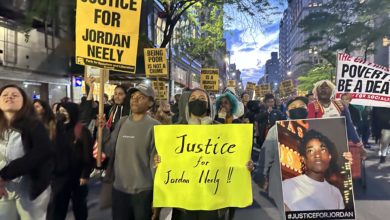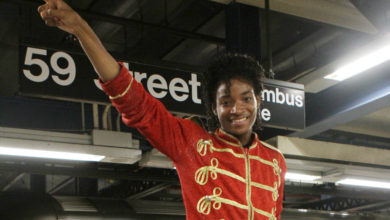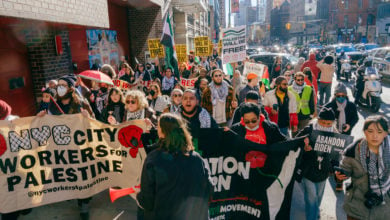The recent disaster following Hurricane Katrina in Louisiana, Mississippi and Alabama has put a spotlight on the dire realities facing tens of millions of African American and other oppressed people in the United States. The government�s failure to plan for or carry out swift evacuation and relief efforts displayed what little concern the U.S. ruling class has for working and poor people. The magnitude of the current crisis could have been lessened and perhaps prevented almost entirely.
It is impossible to ignore the racism and class issues associated with this natural disaster�yet this is precisely what the Bush administration and racist pundits are now doing. Of the more than 300,000 people in the New Orleans metropolitan area who could not evacuate, the vast majority were Black.
Of course, Katrina did not go out of its way to affect Black people. It destroyed nearly everything in its path. But it is no surprise that the people most affected by the hurricane are Black. The poor, predominately Black population of New Orleans was disproportionately affected because they were least able to escape its path.
They did not own cars or have access to other means of transportation. They could not afford airline tickets or pay for hotels.
Black leaders and progressives of all nationalities have pointed out the undeniable racism in the U.S. government�s response to the hurricane. The Rev. Jesse Jackson suggested that racial discrimination and indifference to Black suffering were at the root of the disaster response. �In this same city of New Orleans where slave ships landed, where the legacy of 246 years of slavery and 100 years of Jim Crow discrimination, that legacy is unbroken today.� (Billings Gazette, Sept. 3)
Truly, there is nothing new in the overall disregard for Black people displayed by the governmental relief �efforts.� Racism is deeply ingrained in the capitalist system.
What happened in the Gulf States offers a window into the terrible oppression suffered by African Americans under capitalism. Understanding the nature of that oppression is key to building a revolutionary struggle for working- class emancipation in the United States.
Black people have been victims of centuries of slavery, racism, exploitation and violence in the United States. Conditions in the African American communities in the United States�north and south�still reflect the centuries of extreme oppression that began with slavery.
These progressive and important gains made during the civil rights movement and the subsequent Black liberation struggle in the United States did not fundamentally alleviate the poverty and social oppression suffered by large sectors of the Black community.
In many ways, social conditions for Black people are generally worse today than they were 30 years ago. The current crisis in New Orleans and the Gulf States illustrates this reality.
New Orleans: case study of institutionalized racism
New Orleans is one of the poorest cities in the nation. About 30 percent of the residents live below the federal poverty line. Black people make up 67 percent of the city�s population, with 84 percent living below the poverty line.
For Black children, the situation is even worse. Only Mississippi has a higher child poverty rate than Louisiana. According to estimates, roughly half of all children in Louisiana live in poverty. (National Center for Children in Poverty, 2005)
In the days following Hurricane Katrina�s initial impact, over 80 percent of New Orleans was flooded. One of the hardest hit sections of New Orleans is also one of the poorest: the Lower Ninth Ward�a working-class area on the eastern side of the city. More than 98 percent of the region�s residents are Black and according to the 2000 U.S. census, the Lower Ninth Ward has a poverty level of 36.4 percent. A quarter of households have an annual income of less than $10,000 and half live on less than $20,000. Over 52 percent of the population in the ward is categorized as �not in the labor force,� because there are few jobs and people have stopped looking for work. (Greater New Orleans Community Data Center, 2005)
The Lower Ninth Ward was one of the last areas of New Orleans to be developed because it was virtually uninhabitable. It is situated well below sea level over a cypress swamp. In the 1870s, destitute African Americans and immigrant laborers who were desperate for housing, but unable to afford living in other parts of the city, risked flooding and disease to move there. They did so because they had nowhere else to go.
Over the years, the government provided few services to the area and did little to protect it from flooding. Because of its national and class composition, however, the Lower Ninth Ward became a bastion for working-class activism.
Many residents of this ward were among the hundreds of thousands who lacked the ability to leave the city.
The area had been battered by hurricanes well before Katrina. In 1965, Hurricane Betsy ravaged the Lower Ninth Ward, flooding 80 percent of the area. Of the 81 total deaths caused by Betsy, most came from the Lower Ninth Ward. Residents complained that they did not receive sufficient financial assistance to revitalize the area. Many commercial and industrial businesses moved out, worsening the situation for the already poor residents.
By the time Katrina hit this September, the storm easily overpowered the inadequate levees that protected the region, producing 20-foot-high floodwaters. The levees in place were too small and had not been reinforced for decades. Some people in the ward were rescued from their rooftops, but many were stranded and hundreds, possibly thousands, died. Nearly everyone in the area lost their homes and possessions.
The community received no help when it was time to evacuate. The only attention they did receive was in the form of racist repression from local police and the military. In the Lower Ninth Ward and beyond, Black people were branded as criminal �looters.� Serving and protecting private property instead of human life, the military and New Orleans police received �shoot to kill� orders for all people who broke into grocery stores to obtain food and supplies necessary for survival.
This brutality is how the ruling class deals with all potentially explosive situations in oppressed communities. It is exactly how they have responded to modern urban rebellions�most of which were in reaction to incidents of police brutality against Black people.
Katrina�s immediate aftermath highlights a significant reality of U.S. society��natural� disasters don�t treat everyone alike. The inequalities already present in the system are exacerbated during a time of crisis.
Black oppression today
The immediate situation for people from New Orleans and the Gulf States is devastating. But social indices in the most oppressed neighborhoods, like the Lower Ninth Ward, show that things were very bad for Black people long before the hurricane hit.
The biggest divide between Blacks and whites in the United States is economic status. The Black poverty rate was three times greater than the white poverty rate in 2002. At the very slow rate at which the Black-white poverty gap has been narrowing since 1968, it would take 150 years�until 2152�to close. (The State of the Dream 2004: Enduring Disparities in Black and White, United for a Fair Economy)
The unemployment level of Black people is more than double that of white people, 10.8 percent to 4.7 percent�a wider gap than in 1972. Unemployment rates for Black men age 20 and over remains in double digits. (The State of Black America 2005, National Urban League)
Black people who find work are making far less than their white counterparts. For every dollar of white per capita income, African Americans earned 55 cents in 1968 and only 57 cents in 2001. At this pace, it would take African Americans 581 years to get the remaining 43 cents.
Health related figures also show a great disparity based on nationality.
On average, Black people are twice as likely as whites to die from disease, accidents and homicide at every stage of life. Black men have the lowest life expectancy rate in the country. Black people still get far fewer operations, tests, medications and other life-saving treatments than white people. (Washington Post, Aug. 18, 2005)
More than 886,000 deaths could have been prevented from 1991 to 2000 if African Americans had received the same health care as white people, according to the December 2004 issue of the American Journal of Public Health. Millions of Black people have no health care at all.
The lack of affordable and accessible health care hurts children a great deal. Black infants are almost two and a half times as likely as white infants to die before age one�a greater gap than in 1970.
Perhaps the most overt tool of oppression against Black people is the use of U.S. prisons to incarcerate hundreds of thousands. Prisons are a modern extension of slavery and racist terror against oppressed people. They are an essential part of the capitalist state apparatus, meant to criminalize oppressed people and condition them not to rise up against the ruling class.
Although crime rates have decreased in the United States, every year federal, state and local incarceration rates rise, particularly among Black men. Black males born today have a 1-in-3 chance of going to prison during their lifetime, compared to a 1-in-17 chance for white males.
Of the more than two million prisoners in the United States, nearly half are Black. African Americans are three times more likely than whites to be incarcerated, and the average jail sentence for the same crime is six months longer for Blacks than whites.
Education and housing statistics also underscore the profound racism facing Black people in the United States.
What can change the situation?
Many of the democratic gains won by the civil rights movement have been eroded. But retaking these gains and extending them is possible. Just as Black people fought for justice and equality in the 1960s and 70s, a renewed struggle against racism can emerge.
Fighting racism is central to advancing the class struggle of all U.S. workers. The racism and national oppression inherent to capitalist class rule has targeted Black people for four centuries. Bigotry and prejudice have been the chief instruments that the capitalists have used to divide the working class and politically bind a significant sector of white workers to their own oppressors�with the predictable result of weakening all unions and working class organizations.
This will change. The political and class struggle is growing in the United States. Increasingly, it is African American, Latino and other oppressed workers who are providing leadership to these struggles. The fight against racism is an integral part of the class struggle. Such a struggle by working and oppressed people of all nationalities in the United States will lead to true liberation from racism and class inequality.
Reparations now!
25 7 minutes read






